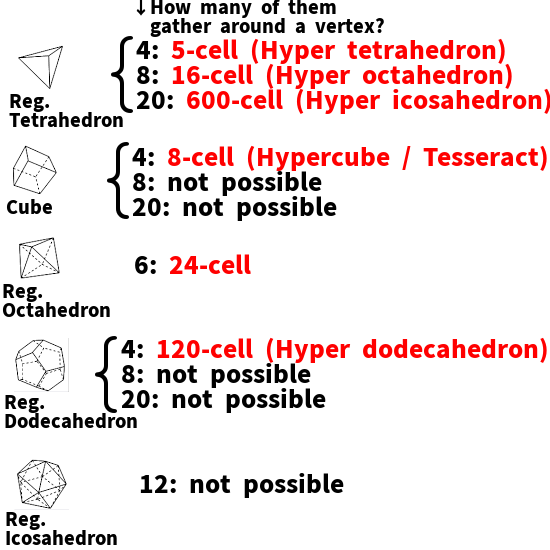There are 6 kinds of regulars in 4D geometry.

These are categorized:
- 3 of them are infinite families; they exist throughout all dimensions.
- 2 of them are extensions of Dodecahedron and Icosahedron in 3D.
- 1 of them is unique to 4D.
This article features the first three.
There are several ways to define regular. Anyway, regular shapes have the highest symmetry in that dimension. 4D regulars are made by 3D regulars.
Abbreviations
On this website, we use short names coined by Jonathan Bowers. Examples:
- Tet: Tetrahedron.
- Oct: Octahedron.
- Doe: Dodecahedron.
- Ike: Icosahedron.
These are pronounced according to the rules of phonics, just like ordinary Eng words.
Pen: Pentachoron (5-cell body)
This is made of these elements: Cells: 5 Tet's. Faces: 10 triangles. Edges: 10. Vertices: 5.
This is the simplest one, in terms of number of vertices. It is the only one of the six with odd numbers of vertices and cells.
This is a pyramid based on Tet. Four of five points form a Tet, and the fifth point is "above" it, connecting to all existing points.
In 4D space, some of the coordinate values must be irrational number. To construct it easily, choose unit points in 5D space: \((1,0,0,0,0)\) and its permutations.
Tes = Octachoron (8-cell body)
Elements: 8 cubes. 24 squares. 32 edges. 16 vertices.
Commonly known as tesseract. The 4D hypercube, also called measure polytopes. Natural extension of the square and cube.
Just like the square and cube, we can think of this as the origin of all 4D shapes.
This is a prism based on the cube. Two cubes are in different realms, and all corresponding points are connected, making 6 additional cubes.
Among hypercubes in all dimensions, the Tes is the only one that the circumradius - distance between the center and any vertex - is equal to the edge length. This is because the square root of the dimensions, which is the diagonal length of the hypercube, is the integer 2 in 4D.
Hex = Hexadecachoron (16-cell body)
Elements: 16 Tet's. 32 triangles. 24 edges. 8 vertices.
The 4D cross polytope, also called orthoplex. Extension of Oct in 3D. The Oct has 6 vertices, 4 of which form a square; other two are above and below the square. Thus, the Oct is two square pyramids attached at their bases.
Similarly, in 4D, the Hex is formed by adding 2 vertices "above and below" the Oct. Two octahedral pyramids attach on the bases to form a Hex.
Additionally, just like the Oct is a triangular antiprism, the Hex is a tetrahedral antiprism.
Among orthoplexes in all dimensions above 2D, the Hex is the only one that is a space-filling shape.
Duals
The dual of a 4D shape is a shape whose vertices and cells are switched, and edges and faces are switched.
Dual relationships of regulars are described below:
- The Pen is self-dual.
- The Tes and Hex are duals.
- The Ico (24-cell) is self-dual.
- The Hi (120-cell) and Ex (600-cell) are duals.
Since the regulars are the shapes with the highest symmetry, the dual relationships are most powerful. When we have trouble analyzing regulars, looking at their dual helps us.
Links
Jonathan BowersPolytope Wiki
Original Wiki
4次元の半正多胞体
アコニック・ランド (Link expired)
4次元図形の基礎雑学
QFBox
四次元への扉 (Link expired)
4次元多胞体を見るWebアプリ
高次元の正多胞体(その5)